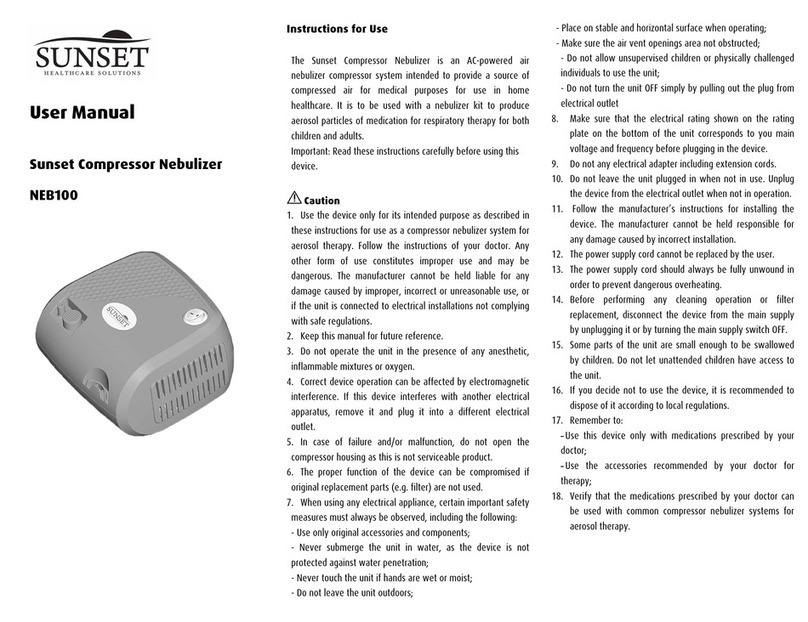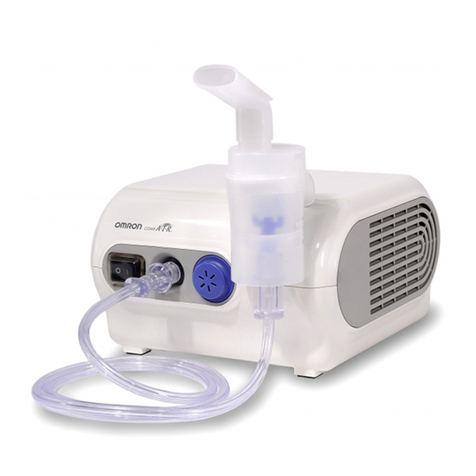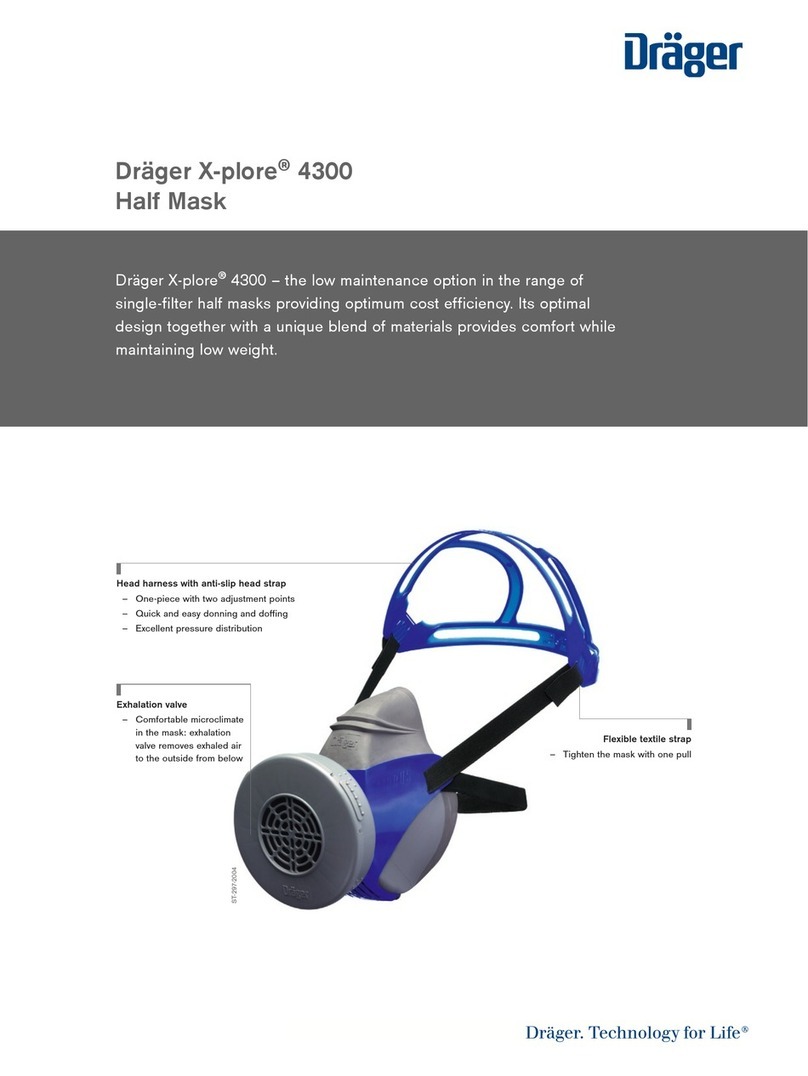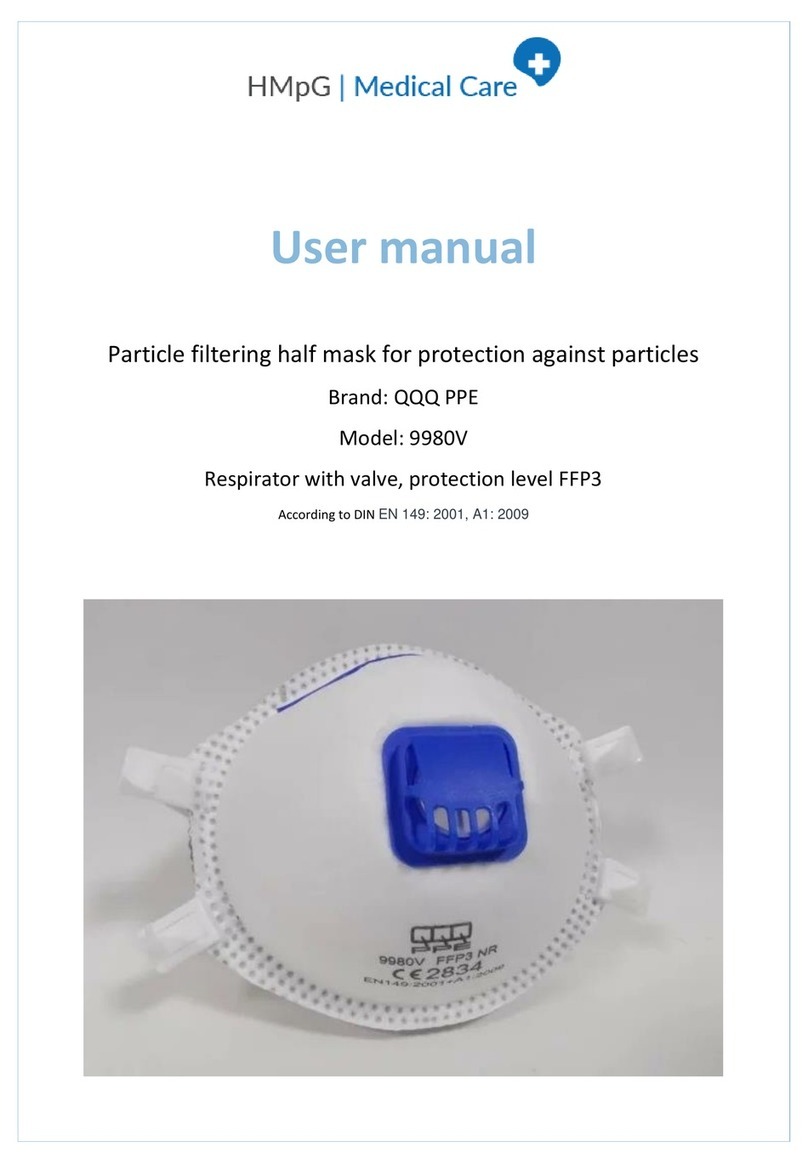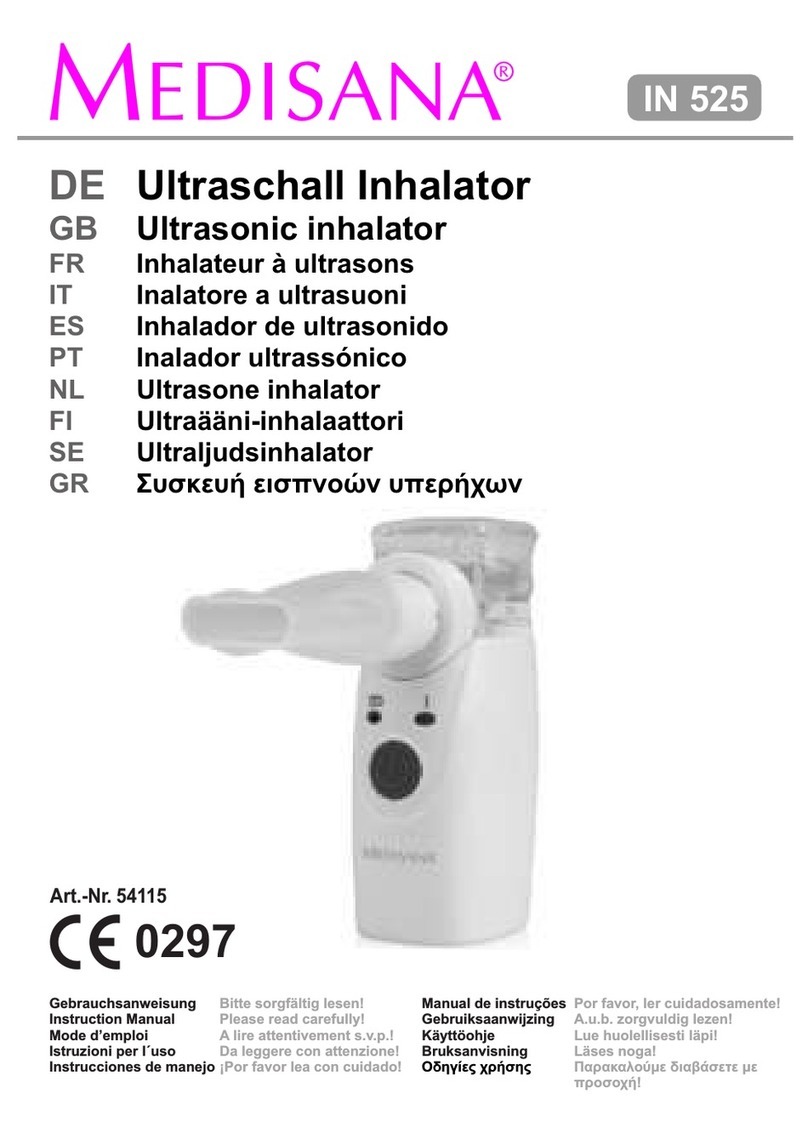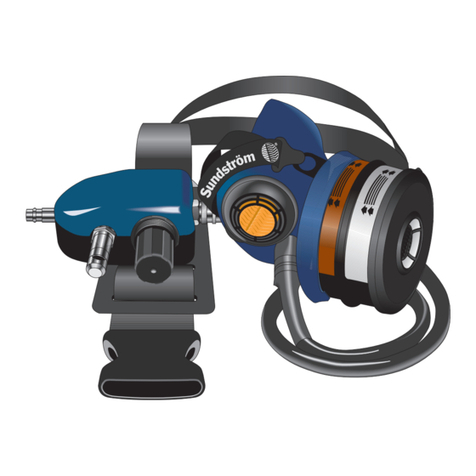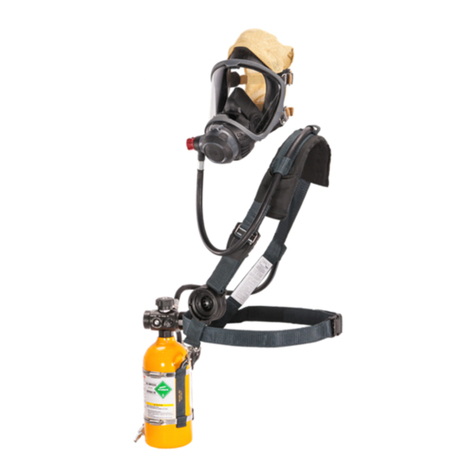Würth 175 User manual

de Atemfilter
Würth 175
Gebrauchsanweisung
4
en Respiratory filter
Würth 175
Instructions for use
11
fr Filtre respiratoire
Würth 175
Notice d'utilisation
18
es Filtro respiratorio
Würth 175
Instrucciones de uso
25
pt Filtro respiratório
Würth 175
Instruções de Uso
32
it Filtro di protezione respiratoria
Würth 175
Istruzioni per I'uso
39
nl Ademfilter
Würth 175
Gebruiksaanwijzing
46
da Åndedrætsfilter
Würth 175
Brugsanvisning
53
fi Hengityssuodatin
Würth 175
Käyttöohje
59
no Pustefilter
Würth 175
Bruksanvisning
66
sv Andningsfilter
Würth 175
Bruksanvisning
72
et Õhufilter
Würth 175
Kasutusjuhend
78
lt Kvėpavimo filtras
Würth 175
Naudojimo instrukcija
84
lv Respiratoru filtrs
Würth 175
Lietošanas instrukcija
91
pl Filtr oddechowy
Würth 175
Instrukcja obsługi
98
ru
Pеспираторный фильтр
Würth 175
Руководство по
эксплуатации
105
hr Respiratorni filtar
Würth 175
Upute za uporabu
112
sl Dihalni filter
Würth 175
Navodila za uporabo
118
sk Filter na ochranu dýchacích ciest
Würth 175
Návod na použitie
125
cs Dýchací filtr
Würth 175
Návod k použití
132

bg дихателен филтър
Würth 175
Инструкция за употреба
139
ro Filtru de respiraţie
Würth 175
Instruciuni de utilizare
146
hu Légzési szűrő
Würth 175
Használati utasítás
153
el Φίλτρο αναπνοής
Würth 175
Οδηγίες χρήσης
160
tr Solunum filtresi
Würth 175
Kullanm talimatı
167
zh 呼吸过滤器
Würth 175 使用说明
174
sr Respiratorni filteri
Würth 175
Uputstvo za korišćenje
179

2
1
2
12
B
A
1

4
Zu Ihrer Sicherheit
Gebrauchsanweisung beachten! Jede Handhabung an dem Atem-
filter setzt die genaue Kenntnis und Beachtung dieser Gebrauchs-
anweisung sowie der Gebrauchsanweisung des jeweils
verwendeten Atemanschlusses (HM 175 oder VM 175) voraus. Die
Atemfilter sind nur für die beschriebene Verwendung bestimmt.
Beschreibung
Diese Gebrauchsanweisung beschreibt Pad-Partikel-Filter, Parti-
kelfilter, Gasfilter und Kombinationsfilter, die unter der Bezeich-
nung Atemfilter 175 zusammengefasst sind.
Partikelfilter und Pad-Partikel-Filter werden verwendet, um den
Anteil schädigender Partikel in der eingeatmeten Luft zu reduzie-
ren.
Pad-Partikel-Filter können mit einer Pad-Kappe auf Gasfilter auf-
gesetzt und an der Maske befestigt werden.
Gasfilter werden verwendet, um bestimmte schädigende Dämpfe
und Gase in der eingeatmeten Luft zu reduzieren.
Kombinationsfilter werden verwendet, wenn sowohl Partikel als
auch Gase und Dämpfe auftreten können.
Verwendungszweck
Atemfilter 175 bilden mit Würth Halbmasken (HM 175) oder Voll-
masken (VM 175) ein Filtergerät. Filtergeräte filtern aus der vom
Träger eingeatmeten Luft innerhalb der angegebenen Grenzwerte
bestimmte Gase, Dämpfe und Partikel.
Zulassungen
Die Atemfilter sind zugelassen nach:
EN 14 387
EN 143:2000/A1:2006
(EU) 2016/425
AS/NZS 1716:2012.
Konformitätserklärung: siehe www.wuerth-documents.com
Einschränkungen des Verwendungszwecks
– Filter nicht in mit Sauerstoff angereicherter Atmosphäre ein-
setzen.
– Bauartbedingt können Würth Atemfilter bei bestimmungsge-
mäßer Verwendung auch in den als Zone 1 und 2 bzw. 21 und
22 ausgewiesenen Bereichen eingesetzt werden.
– Filtergeräte bei Verdacht auf Schadstoffe mit geringen Warnei-
genschaften (Geruch, Geschmack, Reizung der Augen und
Atemwege) nicht einsetzen.
– Partikel- und Kombinationsfilter schützen vor Inkorporation
von radioaktiven Partikeln. Sie bieten jedoch keinen Schutz
vor Strahlung von radioaktiven Stoffen oder vor Strahlenschä-
den.
– Gasfilter mit der Bezeichnung A1 oder A2 dürfen nicht gegen
Niedrigsieder eingesetzt werden. Das gilt auch für entspre-
chende Mehrbereichsfilter.

5
Symbolerklärung
Achtung! Gebrauchsanweisung beachten.
Lagerfähig bis …
Temperaturbereich der Lagerbedingungen
Maximale Feuchte der Lagerbedingungen
Immer zwei Atemfilter gleichen Typs verwenden.
R Die Kennzeichnung mit „R“ bedeutet, dass durch zusätzli-
che Prüfungen nach EN 143:2000/A1:2006 nachgewiesen
wurde, dass das Partikelfilter bzw. der Partikelfilterteil des
Kombinationsfilters für die Wiederverwendung nach Aero-
solexposition (Verwendung über mehrere Arbeitsschich-
ten) geeignet ist.
NR Die Kennzeichnung mit „NR“ bedeutet, dass durch zusätz-
liche Prüfungen nach EN 143:2000/A1:2006 nachgewie-
sen wurde, dass das Partikelfilter bzw. der Partikelfilterteil
des Kombinationsfilters nur für maximal eine Arbeits-
schicht verwendet werden darf.
D Der Dolomitstaub-Einspeichertest gegen Verstopfen nach
EN 14387 wurde erfolgreich bestanden.
Voraussetzungen für den Gebrauch
Für den Gebrauch von Filtergeräten sind die EN 529 sowie
EN 14 387 und EN 143:2000/A1:2006 und die entsprechenden
nationalen Regeln maßgeblich. Der Benutzer eines Filtergerätes
muss im Gebrauch unterwiesen, geeignet und atemschutztauglich
sein.
Den gültigen nationalen Vorschriften bezüglich der Benutzung von
Filtergeräten genau Folge leisten (in Deutschland z. B. DGUV-R
112-190, in Australien und Neuseeland z. B. AS/NZS 1716:2012).
– Die Umgebungsverhältnisse (insbesondere Art und Konzen-
tration der Schadstoffe) müssen bekannt sein.
WARNUNG
Filtergerät bei Unklarheiten über Verwendungszweck
oder Einsatzbedingungen nicht verwenden. Bei der Ver-
wendung folgende Hinweise beachten.
Andernfalls kann dies beim Benutzer zu schweren Ge-
sundheitsschäden oder sogar zum Tod führen.
-10C
+55C
<90%
!

6
– Der Sauerstoffgehalt der Umgebungsluft darf nicht unter fol-
gende Grenzwerte sinken:
17 Vol.-% in Europa mit Ausnahme der Niederlande, Belgien,
UK
19 Vol.-% in den Niederlanden, Belgien, UK, Australien, Neu-
seeland.
Für andere Länder nationale Vorschriften beachten!
– Die Einsatztemperatur liegt zwischen –30 °C und 60 °C.
– Es muss sichergestellt sein, dass sich die Umgebungsatmo-
sphäre nicht nachteilig verändern kann.
– Unbelüftete Behälter, Gruben, Kanäle usw. dürfen mit Filterge-
räten nicht betreten werden.
– Eignung des Atemfilters prüfen: Kennfarbe, Kennzeichnung,
Verfalldatum.
– Notwendigkeit weiterer persönlicher Schutzausrüstungen und
deren Kompatibilität prüfen.
– Gasfilter schützen nicht gegen Partikel! Partikelfilter schützen
nicht gegen Gase und Dämpfe! Im Zweifelsfall Kombinations-
filter verwenden!
– Schadgase, die schwerer als Luft sind, können sich in Boden-
nähe in höheren Konzentrationen anreichern.
– Für niedrigsiedende organische Verbindungen (Siedepunkt
≤65 °C) sind spezielle Anwendungsregeln (in Deutschland
z. B. DGUV-R 112-190) und Einsatzbeschränkungen zu be-
achten!
– Beschädigte Atemfilter oder Atemfilter aus beschädigtem Beu-
tel nicht benutzen.
– Atemfilter, deren Verfallsdatum überschritten ist (Angaben auf
dem Atemfilter), nicht verwenden.
– Es müssen immer beide Atemfilter gleichzeitig gewechselt
werden. Beide Atemfilter müssen immer aus derselben Ver-
packungseinheit sein.
– Bei Weiterverwendung von Atemfiltern sicherstellen, dass die
Weiterverwendung zulässig und die Restgebrauchsdauer aus-
reichend ist.
– Beim Einsatz von Partikelfiltern gegen Partikel radioaktiver
Stoffe, luftgetragene biologische Arbeitsstoffe und Enzyme die
Wiederverwendbarkeit prüfen; gegebenenfalls an Würth wen-
den.
– Filterpaare, die schwerer als 300 g sind, nur mit einer Vollmas-
ke verwenden (siehe Tabelle 1).

7
Legende:
X: kann mit Halbmaske HM 175 oder Vollmaske VM 175 ver-
wendet werden
O: darf nur mit Vollmaske VM 175 verwendet werden
Kriterien für die Auswahl von Filtergeräten (gemäß der
deutschen Richtlinie DGUV-R 112-190)
Tabelle 1:
Filtertyp Benennung Sachnum-
mer
Filter
ohne
Zubehör
plus
Pad-
Partikel-
filter
Gasfilter (Paar)
A2 0899 175 010 X X
ABEK1 0899 175 012 X X
Partikelfilter (Paar)
P3 R 0899 175 016 X
Pad P2 0899 175 014 X
Kombinationsfilter (Paar)
ABEK1HgP3 R D 0899 175 013 X
A2P3 R D 0899 175 011 X
ABEK2HgP3 R D 0899 175 101 O
Tabelle 2: Auswahl Filtergeräte
Filtergerät Vielfaches1) des
Grenzwertes2)
1) Bei Filtergeräten mit Kombinationsfilter gelten die jeweiligen Vielfachen des
Grenzwertes für den Gas- oder Partikelfilterteil, und zwar jeweils der schärfere
Wert.
2) Änderung durch nationale Regelungen möglich
Halb-/Viertelmaske mit P1-Filter 4
Halb-/Viertelmaske mit P2-Filter 10
Vollmaske mit P2-Filter 15
Halb-/Viertelmaske mit P3-Filter3), Gasfilter4)
3) Für Australien und Neuseeland (SAI Global) gilt: P3-Filter bieten nur in Kombina-
tion mit Vollmasken einen P3-Schutz. Mit Halbmasken bieten sie einen Schutz wie
P2-Filter ohne Einschränkung der Verwendung.
4) Sofern damit nicht bereits die auf das Gasaufnahmevermögen bezogenen höchst-
zulässigen Einsatzkonzentrationen von 1000 ml/m3(0,1 Vol.-%) in Gasfilter-
klasse 1, 5000 ml/m3(0,5 Vol.-%) in Gasfilterklasse 2 überschritten werden.
30
Vollmaske mit P3-Filter, Gasfilter4) 400

8
Tabelle 3: Gasfilter
Typ Kennfar-
be
Hauptanwendungsbereich Klasse
A braun Organische Gase und Dämpfe mit
Siedepunkt >65 °C
1
2
B grau Anorganische Gase und Dämpfe,
z. B. Chlor, Hydrogensulfid
(Schwefelwasserstoff), Hydrogen-
cyanid (Blausäure) – nicht gegen
Kohlenstoffmonoxid
1
2
E gelb Schwefeldioxid, Hydrogenchlorid
(Chlorwasserstoff) und andere
saure Gase
1
2
K grün Ammoniak und organische Am-
moniak-Derivate
1
2
Hg-P31)
1) Maximale Gebrauchsdauer 50 Stunden (nach EN 14 387, Kennzeichnung: Hg-P3:
max. 50 h).
rot-weiß Quecksilber –
Tabelle 4: Partikelfilter
Typ Kenn-
farbe
Klasse Abscheide-
leistung
Einschränkungen
P weiß 1 klein Nicht gegen krebserzeugen-
de und radioaktive Stoffe,
luftgetragene biologische Ar-
beitsstoffe der Risikogruppe
2 und 3 und Enzyme
2 mittel Nicht gegen radioaktive Stof-
fe, luftgetragene biologische
Arbeitsstoffe der Risikogrup-
pe 3 und Enzyme
3 groß Für Australien und Neusee-
land (SAI Global) gilt: P3-Fil-
ter bieten nur in Kombination
mit Vollmasken einen P3-
Schutz. Mit Halbmasken bie-
ten sie einen Schutz wie P2-
Filter ohne Einschränkung
der Verwendung.

9
Gebrauch
Atemfilter sorgfältig behandeln: nicht stoßen, nicht fallen lassen
usw.!
Die Luft aus dem Filter kann warm sein und das Filtergehäuse
kann sich während des Gebrauchs stark erwärmen. Das ist ein
Zeichen für die korrekte Funktion des Filters.
Beutel erst kurz vor dem Gebrauch öffnen. Nicht mit spitzen
Gegenständen in das Atemfilter bohren.
Atemfilter dicht mit dem Atemanschluss verbinden.
Atemfilter und Atemanschlüsse nur in den genannten Kombi-
nationen benutzen (siehe Tabelle 1).
Zwei Atemfilter einsetzen (ungekapselte Partikelfilter in Kom-
bination mit dem Gasfilter, Partikelfilter, Gasfilter oder Kombi-
nationsfilter)
(siehe Bild A)
Atemfilter positionieren (1) – Strichmarkierungen gegen-
über! – und bis zum Anschlag verriegeln (2), indem das Atem-
filter bis zum spürbaren Anschlag nach unten gedreht wird.
Das Lösen des Atemfilters erfolgt entgegengesetzt.
Pad-Partikel-Filter befestigen (am Gasfilter)
(siehe Bild B)
Pad-Partikel-Filter in die Pad-Kappe einlegen (Beschriftung
von außen sichtbar) und rundherum einrasten (1).
Pad-Kappe mit Pad-Partikel-Filter auf dem Gasfilter einklicken
(2).
Sicherstellen, dass der Sitz des Pad-Partikel-Filters während
des Einsatzes nicht verändert wird.
Gebrauchsdauer
Allgemein gültige Richtwerte für die Gebrauchsdauer können nicht
angegeben werden, weil sie stark von den äußeren Bedingungen
abhängen, z. B. von Art und Konzentration des Schadstoffs, Luft-
bedarf des Benutzers, Luftfeuchte und Temperatur.
– Gasfilter müssen spätestens ausgetauscht werden, wenn der
Benutzer den Durchbruch feststellt (Geruchs-, Geschmacks-
oder Reizerscheinungen).
– Partikelfilter müssen bei einer deutlichen Zunahme des Atem-
widerstandes ausgetauscht werden.
– Kombinationsfilter müssen bei Durchbruch und/oder erhöhtem
Atemwiderstand ausgetauscht werden.
WARNUNG
Bajonettanschluss nicht einseitig einsetzen! Atemfilter
beim Verriegeln nicht verkanten!
!

10
Lagerung
Atemfilter in Räumen mit normaler Feuchte (<90 % rel. Feuchte),
Temperatur (–10 °C bis 55 °C) und nicht belasteter Luft lagern. Die
maximale Lagerzeit erstmalig geöffneter Atemfilter beträgt
6 Monate, sofern das Filter nach dem Gebrauch eingeschweißt
wird.
Die Lagerfähigkeit kann beeinträchtigt werden, wenn die Filter un-
ter anderen Bedingungen gelagert werden.
Entsorgung
Atemfilter als gefährlichen Abfall entsprechend den jeweils gelten-
den örtlichen Abfallbeseitigungsvorschriften entsorgen.

11
For your safety
Strictly follow the instructions for use. Any use of the respiratory fil-
ter requires the full understanding and strict observation of these
instructions for use and the instructions for use of the used fa-
cepiece (HM 175 or VM 175). The respiratory filters are only to be
used for the purpose specified here.
Description
These instructions for use refer to pad particle filters, particle filters,
gas filters and combination filters subsumed under the name of
respiratory filters 175.
Particle filters and pad particle filters are used to reduce the con-
tent of harmful particles in the breathing air.
Pad particle filters can be fitted to the gas filter using a pad cap and
can be attached to the mask.
Gas filters are used to reduce certain harmful vapours and gases
in the breathing air.
Combination filters are used when particles as well as gases and
vapours are likely to occur.
Intended use
Respiratory filters 175 combined with Würth half masks (HM 175)
or full face masks (VM 175) form a filter apparatus set. A filter ap-
paratus filters certain gases, vapours and particles from the air
breathed by the wearer within the specified limit values.
Approvals
The respiratory filters are approved according to:
EN 14 387
EN 143:2000/A1:2006
(EU) 2016/425
AS/NZS 1716:2012
Declaration of conformity:
see www.wuerth-documents.com
Limitation in the intended use
– Do not use the filters in oxygen-enriched atmospheres.
– Depending on their design, Würth respiratory filters can also
be used in areas designated as Zone 1 and 2 or 21 and 22 if
used as intended.
– Do not use filter apparatus sets when there is a suspicion of
contaminants with low warning properties (smell, taste, irrita-
tion of eyes and airways).
– Particle filters and combined filters protect against the incorpo-
ration of radioactive particles. They do not, however, offer any
protection against the radiation from radioactive materials or
against radiation damage.
– Gas filters with the designation A1 or A2 must not be used in
the presence of low-boiling groups. This also applies to the
corresponding multi-use filters.

12
Explanation of symbols
Important! Strictly follow the instructions for use.
Suitable for storage until …
Temperature range of storage conditions
Maximum humidity of storage conditions
Always use two respiratory filters of the same type.
R The "R" mark means that it has been demonstrated
through additional tests in accordance with EN 143:2000/
A1:2006 that the particle filter or the particle filter compo-
nent of the combination filter is suitable for reuse after aer-
osol exposure (use during several working shifts).
NR The "NR" mark means that it has been demonstrated
through additional tests in accordance with EN 143:2000/
A1:2006 that the particle filter or the particle filter compo-
nent of the combination filter may only be used during at
most one working shift.
D The dolomite dust clogging test according to EN 14387
was successfully passed.
Prerequisites for use
EN 529 and EN 14 387 as well as EN 143:2000/A1:2006 and the
corresponding national regulations are authoritative for the use of
filter apparatus sets. The user of the filter apparatus set must be
duly instructed and both physically and mentally fit to use the res-
pirator apparatus.
Follow exactly the valid national regulations relating to the use
of filter apparatus sets (in Germany, e.g. DGUV-R 112-190, in
Australia and New Zealand, e.g. AS/NZS 1716:2012).
– The ambient conditions (in particular type and concentration of
the contaminants) must be known.
WARNING
The filter apparatus sets are not to be used if there is any
confusion about the purpose of their use or the conditions
in which they are to be used. Observe the following notic-
es when using the filter apparatus set.
Non-observance can result in serious damage to the us-
er's health or even in death.
-10C
+55C
<90%
!

13
– The oxygen content in the ambient air may not decline below
the following limit values:
17 %Vol. in Europe except for the Netherlands, Belgium, UK
19 %Vol. in the Netherlands, Belgium, UK, Australia, New Zea-
land.
For other countries observe the national regulations!
– The operating temperature is between –30 °C and 60 °C.
– It must be ensured that the surrounding atmosphere cannot
change unfavourably.
– Never enter unventilated tanks, pits, canals, etc. when wearing
filter apparatus sets.
– The suitability of the respiratory filter must be checked: colour
code, marking, expiry date.
– Check whether further personal protection equipment is re-
quired and whether such equipment is compatible.
– Gas filters do not protect against particles! Particle filters do
not protect against gases and vapours! In case of doubt, use
combination filters!
– Harmful gases that are heavier than air can accumulate in
higher concentrations at ground level.
– Special application regulations (in Germany e.g. DGUV-R 112-
190) and limitations of use apply to organic compounds having
a low boiling point (boiling point ≤65 °C)!
– Never use a damaged respiratory filter or a respiratory filter
with damaged bag.
– Do not use respiratory filters which have passed their expiry
date (details on filter label).
– Always replace both respiratory filters at the same time. Both
respiratory filters must always be from the same packing unit.
– When continuing to use respiratory filters, ensure that contin-
ued use is permitted and that the remaining service life is ade-
quate.
– When using particle filters against particles of radioactive ma-
terials, airborne biological substances and enzymes, check the
reusability; contact Würth if necessary.
– Filter pairs weighing more than 300 g must only be used with
a full face mask (see Table 1).

14
Legend:
X: can be used with HM 175 half mask or VM 175 full face
mask
O: may only be used with VM 175 full face mask
Criteria for the selection of filter apparatus sets
(according to DGUV-R 112-190)
Table 1:
Filter
type
Name Parts number Filters
without
accesso-
ries
Plus
pad
particle
filters
Gas filter (pair)
A2 0899 175 010 X X
ABEK1 0899 175 012 X X
Particle filter (pair)
P3 R 0899 175 016 X
Pad P2 0899 175 014 X
Combination filter (pair)
ABEK1HgP3 R D 0899 175 013 X
A2P3 R D 0899 175 011 X
ABEK2HgP3 R D 0899 175 101 O
Table 2: Range of filter devices
Filter apparatus set Multiple
1)
of the limit
value
2)
1) For filter apparatus sets with combination filter the most stringent respective multi-
ples of the limit value for the gas or particle filter element apply in each case.
2) Modifications may be possible due to national regulations.
Half mask/quarter mask with P1 filter 4
Half mask/quarter mask with P2 filter 10
full face mask with P2 filter 15
Half mask/quarter mask with P3 filter3), gas fil-
ter4)
3) For Australia and New Zealand (SAI Global) the following applies: P3 filters only
offer a P3 protection in combination with full face masks. With half masks they offer
a protection like P2 filters with no limitation of use.
4) Provided that the maximum admissible usage concentrations of 1000 ml/m3 (0.1
vol.%) in relation to the gas absorption in gas filter class 1, 5000 ml/m3 (0.5 vol%)
in gas filter class 2 have not already been exceeded.
30
full face mask with P3 filter, gas filter4) 400

15
Table 3: Gas filter
Type Colour
code
Main area of application Catego-
ry
A Brown Organic gases and vapours with
boiling point >65 °C
1
2
B Grey Inorganic gases and vapours, e.g.
chlorine, hydrogen sulphide, hy-
drogen cyanide – not against car-
bon monoxide
1
2
E Yellow Sulphur dioxide, hydrogen chlo-
ride and other acid gases
1
2
K Green Ammonia and organic ammonia
derivatives
1
2
Hg-P31)
1) Maximum service life 50 hours (according to EN 14 387,
labelled: Hg-P3 max. 50 h).
Red/
white
Mercury –
Table 4: Particle filter
Type Col-
our
code
Catego-
ry
Filter effi-
ciency
Limitations
P White 1 Small Not against carcinogenic and
radioactive materials, air-
borne biological substances
of risk category 2 and 3 and
enzymes
2 Medium Not against radioactive ma-
terials, airborne biological
substances of risk category 3
and enzymes
3 High For Australia and New Zea-
land (SAI Global) the follow-
ing applies: P3 filters only
offer a P3 protection in com-
bination with full face masks.
With half masks they offer a
protection like P2 filters with
no limitation of use.

16
Use
Handle the respiratory filter with care: do not knock or drop the fil-
ter!
Air from the filter can be warm and the filter housing may become
very hot during use. This shows that the filter is functioning correct-
ly.
Only open the bag immediately before use. Do not bore into
the respiratory filter with sharp objects.
The respiratory filter must be tightly connected to the fa-
cepiece.
Filters and facepieces are only to be used according to the
combinations listed (see Table 1).
Inserting two respiratory filters (unencapsulated particle filters
in combination with the gas filter, particle filters, gas filters or
combination filters
)
(see Figure A)
Position respiratory filter (1) – line markings opposite! – and
lock to the stop (2) by screwing the respiratory filter downward
until the stop is noticeable.
The respiratory filter is removed in the reverse way.
Attaching pad particle filter (to the gas filter)
(see Figure B)
Insert pad particle filter into the pad cap (labelling visible from
outside) and snap into place on all sides (1).
Click pad cap with inserted pad particle filter to the gas filter (2).
Make sure that the fit of the pad particle filter remains un-
changed.
Service life
A general guide to service life cannot be given, as the service life
depends very strongly on the ambient conditions, e.g. nature and
concentration of the contaminant, air requirement of the user, hu-
midity and temperature.
– Gas filters must be replaced at the latest when the user notices
penetration of the filter (odour, taste or irritations).
– Particle filters must be replaced if the breathing resistance in-
creases significantly.
– Combination filters must be replaced when the apparatus has
been penetrated and/or when breathing resistance is in-
creased.
WARNING
Do not insert bayonet connector on one side only! Do not
jam respiratory filter when locking!
!

17
Storage
Respiratory filters must be stored in rooms with normal humidity
(<90 % rel. humidity), temperature (–10 °C to 55 °C) and uncon-
taminated air. The maximum storage time of respiratory filters is 6
months after they have been opened if the filter is sealed again af-
ter use.
The shelf life can be degraded if the filters are stored under differ-
ent conditions.
Disposal
Dispose of respiratory filters as hazardous waste in accordance
with the applicable local waste disposal regulations.

18
Pour votre sécurité
Observer la notice d'utilisation ! Toute utilisation du filtre respira-
toire suppose la connaissance exacte et le respect de cette notice
d’utilisation ainsi que de la notice d’utilisation de la pièce faciale
employée (HM 175 ou VM 175). Le filtre respiratoire est unique-
ment destiné à l’utilisation décrite.
Description
Cette notice d'utilisation décrit les filtres à particules à tampon, les
filtres à particules, les filtres à gaz et les filtres combinés, réunis
sous la désignation filtres respiratoires 175.
Les filtres à particules et les filtres à particules à tampon sont utili-
sés afin de réduire la concentration de particules nocives dans l'air
respiré.
Les filtres à particules à tampon peuvent être montés avec un ca-
puchon de tampon sur les filtres à gaz et être fixés sur le masque.
Les filtres à gaz sont utilisés afin de réduire la concentration de cer-
tains gaz et vapeurs nocifs dans l'air respiré.
Les filtres combinés sont utilisés en présence à la fois de particules
et de gaz ou vapeurs.
Domaine d’application
Les filtres respiratoires 175 forment un appareil filtrant avec les
demi-masques Würth (HM 175) ou les masques intégraux (VM
175). Les appareils filtrants filtrent l’air inspiré par le porteur et
maintiennent certains gaz, vapeurs et particules dans les limites
données.
Homologations
Les filtres respiratoires sont homologués selon :
EN 14 387
EN 143:2000/A1:2006
(UE) 2016/425
AS/NZS 1716:2012
Déclaration de conformité:
voir www.wuerth-documents.com
Limites d'utilisation
– Ne pas utiliser le filtre dans une atmosphère enrichie en oxy-
gène.
– De par leur conception, les filtres respiratoires Würth peuvent
également être utilisés de manière conforme dans les zones 1,
2, 21 ou 22.
– Ne pas utiliser les appareils filtrants pour se protéger contre les
substances toxiques dont les signes avertisseurs (odeur, goût,
irritation des yeux et des voies respiratoires) sont peu percep-
tibles.
– Les filtres à particules et les filtres combinés protègent contre
l'irradiation corporelle par des particules radioactives. Ils
n'offrent cependant pas de protection contre le rayonnement
de particules radioactives ou les dommages dus au rayonne-
ment.

19
– Les filtres à gaz avec la désignation A1 ou A2 ne doivent pas
être utilisés contre les gaz à bas point d'ébullition. Ceci s'ap-
plique également aux filtres polyvalents correspondants.
Explication des symboles
Attention ! Observer la notice d’utilisation.
À utiliser avant le …
Températures limites de stockage
Humidité maximale des conditions de stockage
Toujours utiliser deux filtres respiratoires de même type.
R Le marquage "R“ signifie que le filtre à particules ou la par-
tie du filtre à particules du filtre combiné à été soumis à des
tests supplémentaires selon la norme EN 143:2000/
A1:2006, ce qui le rend apte être réutilisé après l'exposi-
tion à des aérosols (utilisation sur plusieurs équipes).
NR Le marquage "NR“ signifie que le filtre à particules ou la
partie du filtre à particules du filtre combiné ne peut être
utilisé que pour une seule équipe après des tests complé-
mentaires selon la norme EN 143:2000/A1:2006.
D Le test d'absorption de poussière des Dolomites contre
l'obstruction a réussi conformément à EN 14387.
Conditions d’utilisation
Pour l’utilisation d’appareils filtrants, les normes à prendre en
compte sont l’EN 529 ainsi que l’EN 14 387 et l’EN 143:2000/
A1:2006 et les réglementations nationales correspondantes. L’uti-
lisateur d’un appareil filtrant doit être informé de son utilisation, être
apte à l’utilisation et supporter une protection respiratoire.
Respecter scrupuleusement les réglementations nationales en
vigueur sur l’utilisation des appareils filtrants (en Allemagne p.
ex. DGUV-R 112-190, en Australie et en Nouvelle Zélande p.
ex. AS/NZS 1716:2012).
– Les conditions ambiantes (en particulier le type et la concen-
tration des substances toxiques) doivent être connues.
AVERTISSEMENT
Ne pas utiliser l’appareil filtrant, lorsque l’application ou
les conditions d’utilisation sont imprécises. Respecter les
consignes suivantes lors de l’utilisation.
Son non-respect expose l’utilisateur à de graves pro-
blèmes de santé voire à la mort.
-10C
+55C
<90%
!

20
– La concentration en oxygène de l’air ambiant ne doit pas des-
cendre sous les seuils suivants :
17 % vol. en Europe sauf aux Pays-Bas, en Belgique, au
Royaume-Uni
19 % vol. aux Pays-Bas, en Belgique, au Royaume-Uni, en
Australie, en Nouvelle Zélande.
Pour les autres pays, respecter les directives nationales !
– La température d’utilisation se situe entre –30 °C et 60 °C.
– S’assurer qu’il n’y a pas de risque de dégradation des condi-
tions ambiantes.
– Ne pas pénétrer dans des réservoirs, fosses, canalisations,
etc. non ventilés avec des appareils filtrants.
– Vérifier si le filtre respiratoire est approprié: couleur caractéris-
tique, marquage, date de péremption.
– Vérifier s’il est nécessaire d’utiliser des équipements de pro-
tection supplémentaires et s’assurer de la compatibilité de ces
équipements.
– Les filtres à gaz ne protègent pas contre les particules ! Les
filtres à particules ne protègent pas contre les gaz et les va-
peurs ! Dans le doute, utiliser des filtres combinés !
– La concentration des gaz nocifs de densité supérieure à l’air
peut augmenter à proximité du sol.
– Pour les composés organiques à bas point d'ébullition (point
d'ébullition ≤65 °C), des règles d'utilisation spéciales et des
restrictions d'utilisation doivent être respectées (en Allemagne
par ex. DGUV-R 112-190) !
– Ne pas utiliser un filtre respiratoire endommagé ou un filtre res-
piratoire dont l’emballage est endommagé !
– Ne pas utiliser de filtres respiratoires dont la date limite d’utili-
sation est dépassée (indication sur le filtre respiratoire).
– Les deux filtres respiratoires doivent toujours être remplacés
en même temps. Les deux filtres respiratoires doivent toujours
venir du même conditionnement.
– Lors de la réutilisation de filtres respiratoires, s’assurer qu’une
réutilisation est autorisée et que la durée d’utilisation restante
est suffisante.
– Pour l'utilisation des filtres à particules contre les particules de
substances radioactives, les substances biologiques véhicu-
lées par l'air et les enzymes, il est indispensable de vérifier si
la réutilisation est autorisée; si besoin, s'adresser à Würth.
– Les paires de filtres dont le poids est supérieur à 300 g doivent
être utilisés avec un masque intégral (voir Tableau 1).
Table of contents
Languages:
Popular Respiratory Product manuals by other brands

Sundstrom
Sundstrom SR 90 Airline Instructions for use
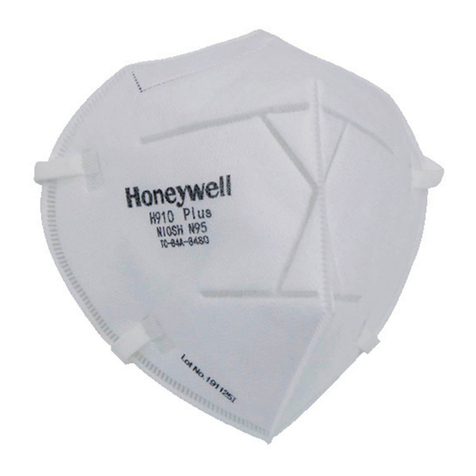
Honeywell
Honeywell H910 Plus User instructions

Trudell Medical International
Trudell Medical International RespiChamber Hospital quick guide
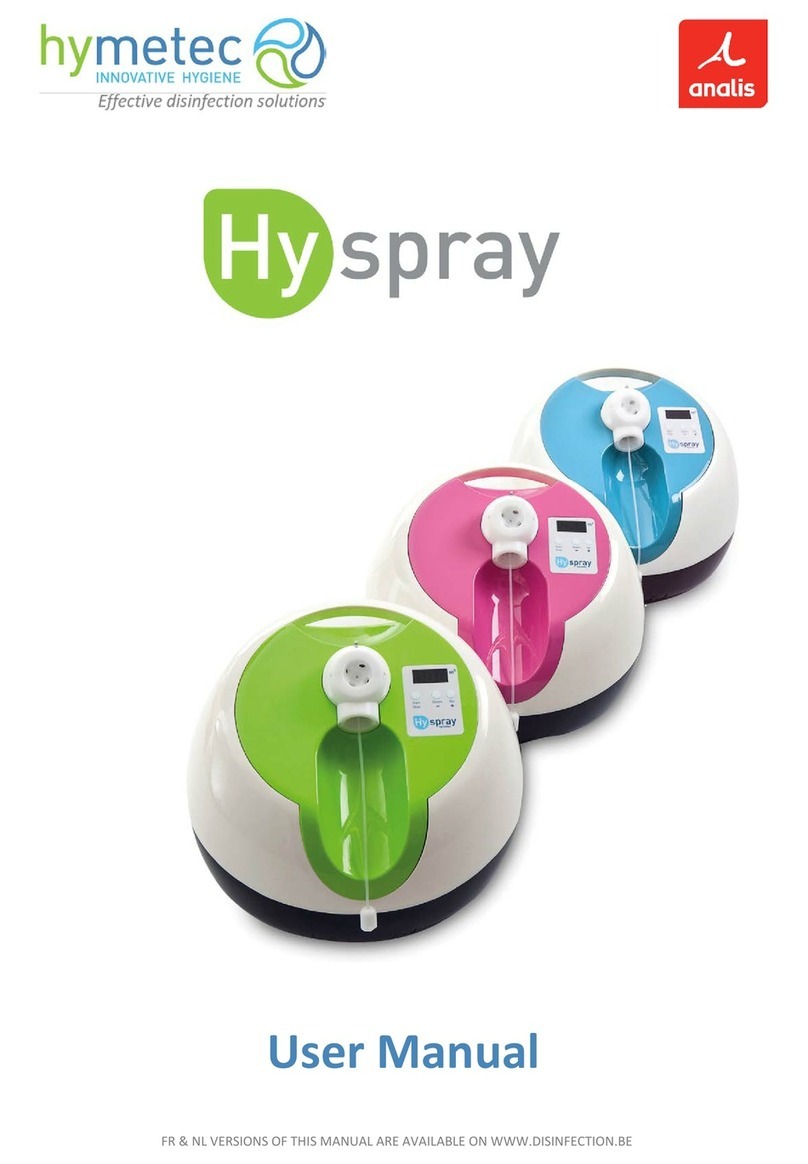
hymetec
hymetec Hyspray user manual
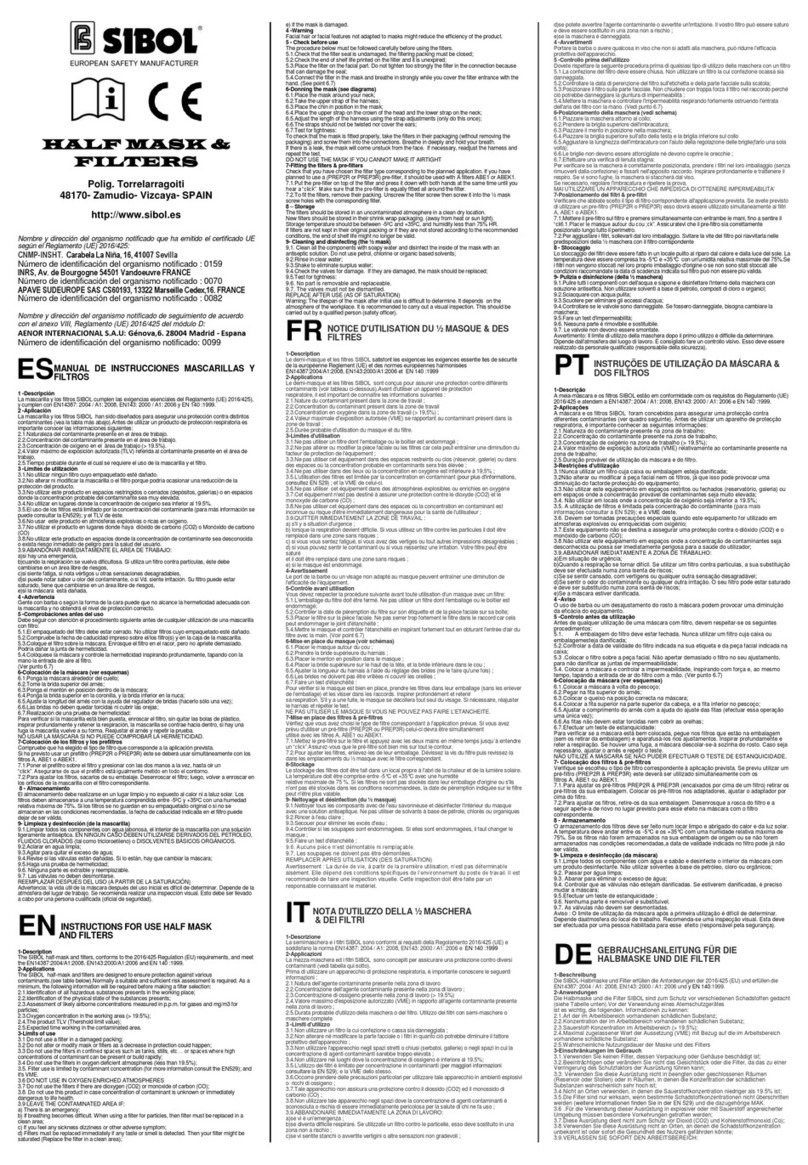
Spasciani
Spasciani Sibol Instructions for use
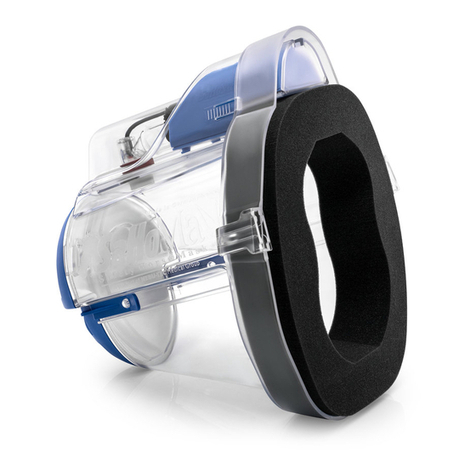
Nebu-tec
Nebu-tec SaHoMa II quick start guide

